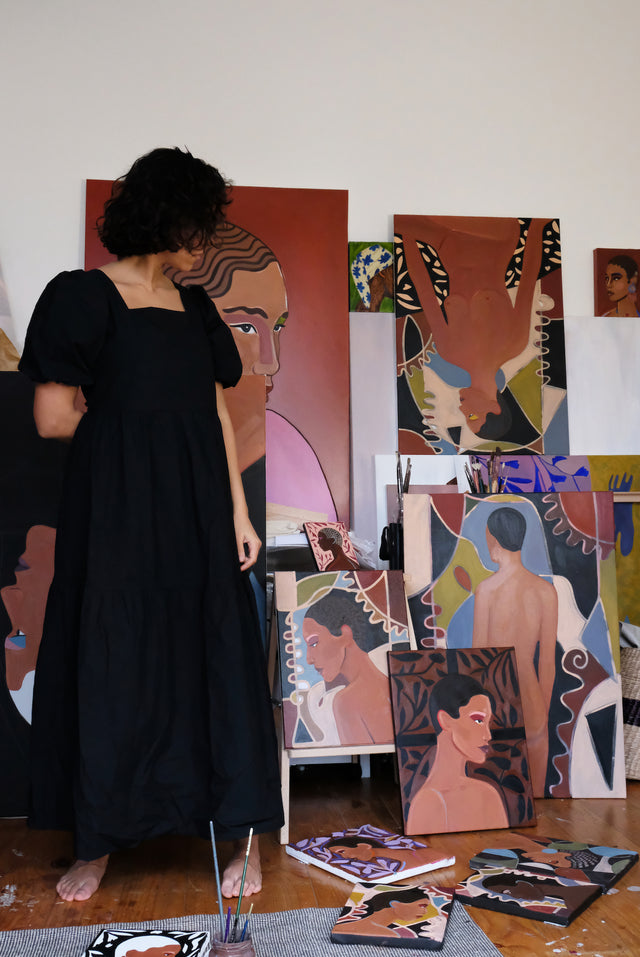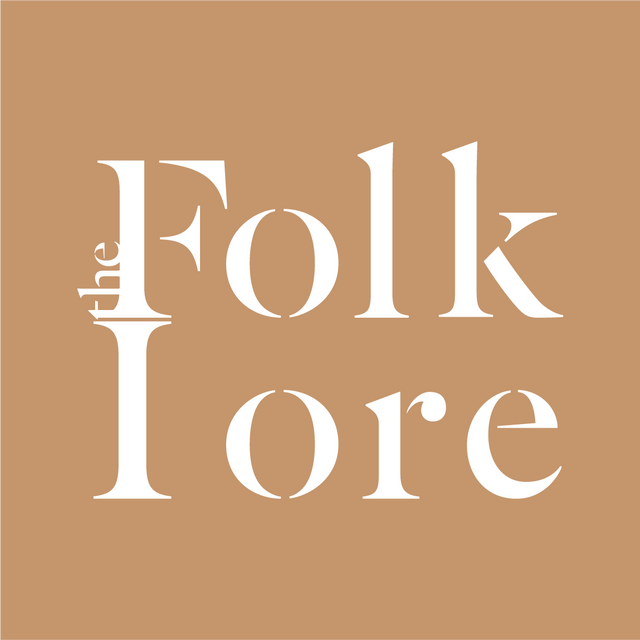Artist Mafalda Vasconcelos on Exploring the Complexities of Identity and Womanhood
For a lot of people, self-expression is the articulation of personality, feelings, or opinions through an artistic activity such as writing, drawing or dancing, and none more so than for Mafalda Vasconcelos. The South African-born artists uses her oil paintings to explore her mixed-race identity, her cultural heritage and the concept of womanhood across generations.
Born in Johannesburg to a Black mother and white Portuguese father, Vasconcelos was raised in Mozambique surrounded by a family of women. Calling her ethnicity a “duality”, she often goes on journeys of self-discovery and ancestral exploration through the visual narratives of her oil paintings that only depict women.
Despite an academic background in fashion and entrepreneurship – she studied Fashion and Design at the University of Westminster and gained an MA in Fashion Entrepreneurship – Vasconcelos says that art has always been her passion and considers herself very lucky to be able to do what she loves for a living.
Beyond her personal experiences with identity, Vasconcelos is a proud Mozambican woman whose heritage also inspires her colorful artwork. For her, growing up in Mozambique meant that the focus was always her family’s Mozambican heritage and culture. They would have small ceremonies for their ancestors, where they wore capulana (Mozambican Ankara) everywhere and had extended family over almost every day. Sadly, due to assimilation, most of the beliefs and traditional culture of the Nharinga ethnic group, from which Vasconcelos’ mother descends, were lost in her great grandmothers’ generation, which is why, today, she chooses to honour and connect to this tradition through her art.
Mafalda Vasconcelos talks to The Folklore about the dichotomy of her mixed ethnicity, why she only paints women and what she hopes viewers take away from her art.

How would you describe yourself? Can you please tell us about your background?
I was born in Johannesburg, South Africa, but I was raised in Mozambique. My parents are Mozambican, my mother is black from the Nharinga ethnic group, and my father is white of Portuguese descent.
My cultural and ethnic background is a mixture, a duality. Living in Mozambique meant that, the focus was always our Mozambican heritage and culture. My culture is my heritage, and I am very proud to be a Mozambican woman.
How did you get into art? Did you always know that you wanted to be an artist?
I never considered the idea of being an artist, partly because my parents never thought that was a real profession and or even a possibility. I got into art by necessity. After finishing my fashion degree, I couldn’t find a job anywhere, so I started selling my fashion illustrations to make some money. It has taken me a while to get where I am at, I have learnt a lot along the way and developed my skills and style beyond what I could have imagined. I am grateful for the journey.

Amma
You were born in South Africa, raised in Mozambique, and now you live and work in Melbourne, Australia. Do these places influence your art at all? If so, in what way?
I spent my formative years in Mozambique and everything I do is influenced by my identity, culture and upbringing, especially in the art I create. The deep sense of nostalgia I feel towards my culture, country and family influences the figures in my work, which are often women in my family or group of friends. In a way, I try to immortalise them through painting, to keep them alive in my memory and to be with them through art since distance is keeping us apart. The colours and textures of my upbringing inform the colours I use in the work, bright colours, natural textures, and geometric patterns are to me, reminiscing of the richness of my culture.
Australia is a beautiful country, but it is only a temporary home for me, there isn’t much influence of it in my art because it doesn’t relate to my identity at all.
You use your art to explore the concept and complexities of identity and womanhood. How did that come about?
I grew up surrounded by women, in a matriarchal home and family. I spent most of my life surrounded by women and have developed a deep sense of admiration and devotion to women, which has been transported into my painting. Being a mixed-race woman, I have always been aware of my feelings of belonging but also confusion towards my identity. I have a strong sense of identity because of my rich culture and yet, I question my identity partly because of my ethnicity. And so, it is this dichotomy that fascinates me, but I also have a desire to explore it further and I try to resolve this on the canvas.
 Self-Portrait
Self-Portrait
You create a lot of self-portraits. Why do you choose to be the subject of your artwork?
Sometimes, I don’t intend to do so. Sometimes, I start painting a portrait of someone else and it ends up looking exactly like me, or I see too much of myself in it. It becomes a mirror and I just go with it. It is strange but happens very often; I start a portrait of a friend and the portrait ends up being of a grandmother. Maybe, subconsciously, I am thinking of someone else when painting.
Other times, it is purposeful. There is in me a need to paint my own identity in that moment.
In addition to your personal identity, where else do you draw inspiration from for your art?
I also draw inspiration from moments of stillness and contemplation, in the emotions one comes to feel in those moments. The idea of time is also one that I think of often when creating. How can I make a moment last longer? How can we transcend time? These questions inspire me enormously.
Which artists are you into right now? What’s the last gallery you visited or exhibition you saw?
Artists I love are Claire Tabouret, Julie Mehretu, Chloe Wise, Toyin Ojih Odutola, Cinthia Sifa Mulanga, Thenjiwe Niki Nkosi and lastly Somaya Critchlow.

Mestiça
You only paint women and female forms. Was it a deliberate choice to only depict women?
I guess I paint what I know. I can relate to being a woman in the world, that is my physical manifestation here. I can relate to other women’s identities and stories. One day, I might transcend my own gender identity and paint independent of it. But now, there is in me a great need to paint the women I know and the divine feminine these women represent.
Your pieces mostly have female names. How do you decide what to call them? Do you name them after people you know?
I don’t call them by their real names unless I feel like it is a real depiction of their identity. Otherwise, I try to focus on a detail of the artwork to name the piece, a descriptive name instead of a generic one. For example: Flora because of a floral detail, Mestiça as it relates to my own “mestiça” (mixed) identity, and so on.
To name my work, I also like to play with language. Portuguese is my mother tongue, and a lot of my paintings have Portuguese names. Other names are in chuwabu, which is my mother’s mother tongue. The language aspect of naming artworks highlights the diversity of my country, which I always try to honour.
What do you want the viewer to learn, take away or feel when they see your artwork?
The importance of being in the present moment. The importance of moments of stillness and of contemplation. The joy one can feel in just being and that in being we can transcend time. And finally, the love and admiration I feel for all Mozambican women, to whom my work is dedicated.
 Portrait of Avo Faneta
Portrait of Avo Faneta
Do you have a favorite piece or do you love them all equally like they’re your children?
My favourite ones tend to be the ones I make unintentionally, as in, the ones I start thinking I’m painting someone, and it ends up being someone else entirely. That is a fun process, to discover unexpectedly that the real intention was a different one.
However, my favourite piece is a small portrait I made of my great grandmother Faneta (above), it started just as I described above and that is part of the reason it is so special to me. She must have been with me in that moment.
What does your studio look like? How do you like to work? Do you like loud music or total silence? What kind of environment do you create for your work? Do you have any rituals?
The act of creating is a ritualistic one for me, in this sense, I am allowed to explore my spirituality through art. I love listening to loud music, usually music that has a tie to my upbringing: bossa nova, African jazz or deep house. The feeling of nostalgia I experience listening to this music is then used as a call to create something that is meaningful to me.
My studio has large windows that allow a lot of light to come in, but also allows me to watch the birds outside, giving me a sense of calm. I like to surround myself with objects that remind me of my identity but also inspire me. Some of these objects are vintage necklaces from Mozambique, ritual masks, trinkets, swatches of fabric, books and shells.

You actually have a fashion background, through both study and work. How would you describe your personal style? Does being an artist influence your look?
I love fashion so much; I think it is part of who I am. I love the idea of embellishing and adorning the sacred, in this case, the body. My style is fluid, it depends on what I am finding inspiring in that moment. But overall, I love natural fabrics with bright colours or patterns. I wear a loft of African wax prints, vintage clothes and denim. For accessories, I love glass beads, wooden beads, and vintage bone beads, as well as silver jewelry.
Being an artist influences my style greatly. In the studio I wear very basic clothes because they always get stained and serve a utilitarian purpose. But outside of the studio I have developed a great appreciation for colour, pattern and textures. You can often see the same colour in my art as in my clothes.

Apart from art, what are your other interests? Where else do you channel your creative energy? What do you do to unwind?
I love fashion and I make my own clothes sometimes. My grandmother was a seamstress and I feel a sense of pride in being able to share that skill with her. I also love sculpting, I love reading about most topics and writing, I love going on walks with my dog. Dancing is also a great passion of mine.
Finally, what is the next thing we can expect from you? What are you working on right now?
An exhibition, if all goes right, in the beginning of 2022. Other than that, I am working on a collaboration with friends Fatuma and Laurinda who own a clothing brand, Collective Closets, for their summer 2022 collection.
All images courtesy of Mafalda Vasconcelos


